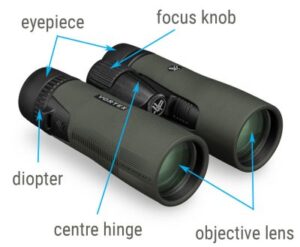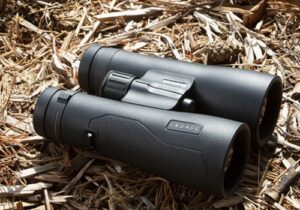How to Choose Binoculars for Hunting
Hunting is a thrilling outdoor activity practiced and enjoyed by many. For both professional and recreational purposes, binoculars for hunting are an invaluable sighting tool that every hunter should have in their tool kit. In this post, we will show you how to choose binoculars for hunting and help you find the right pair for your hunting needs.
Like any other hunting accessories, the market of diverse is diverse. It is therefore important to find a pair that blends best with your hunting habits and needs. With the right pair at your disposal, you will have an easy time scanning games and tracking the mobile ones as they move. A quality set of binoculars will also ensure that you don’t leave anything undiscovered.
But how you do know which unit to pick from the sea of options available on the market? Besides, binoculars come in different budgets, sizes and features for you to choose from based on your individual needs.
The answer to finding the best binoculars for hunting is somewhat complex, but I’ll break down how to choose the right model for the job and your specific budget.
Let’s begin by understanding the anatomy of binoculars.
Binocular’s Anatomy

Three parts make up binoculars: magnification, objective lens, glass, and focus knob.
Magnification
Magnification denotes how many times the binoculars can bring the object closer to you compared to when you view it with your naked eyes. It is represented by a number before the “X” in the binoculars’ configuration.
This means that for a 10x model, the image through the binocular will appear 10 times closer compared to what you would see with your bare eyes.
For hunting, the most popular magnifications are 8x for dense and woody environments, while 10x and 12x are ideal for western hunting.
Objective Lens
In a binocular configuration, the number after the “X” represents the size of the objective lens. This part is responsible for gathering light inside the optics.
It is measured as a diameter in millimeters and the larger the size the better. However, just like magnification, an oversized objective lens means a bigger and heavier optic.
Focus Knob
The focus knob is located on the middle part of the binoculars. Its role is to bring the left and right eyepiece into focus at the same time.
Some hunting binoculars have this knob knurled and ambidextrous to ensure ease of focusing for all users.
Glass
Every brand uses its glass to make binoculars. The top-tier models from renowned brands tend to have better and more high-quality glass to enhance brightness and clarity even in low-light settings. Whatever brand you pick, try and find the best glass possible for your set budget.
Read: Best Vortex Binoculars for Hunting
How to Choose Binoculars for Hunting
 There are so many binoculars available out there, but not all are ideal for hunting. Here are the key things you should consider before settling on any specific product.
There are so many binoculars available out there, but not all are ideal for hunting. Here are the key things you should consider before settling on any specific product.
Hunting Environment
The first thing to consider when looking to buy a pair of binoculars for hunting is the environment you will be hunting in.
The binoculars you require for hunting game in dense timber is different from those that you will need for an open country hunt.
Open Country Hunting
Here you will be scanning and pursuing the game in large, open fields. As such, you will need a high-powered binocular with either a 10x or 12x magnification range.
On top of that, the binoculars for hunting should have a large objective lens diameter to optimize performance in all lighting environments.
Read: Best Hunting Binoculars
Dense Brush and Timber Hunting
Hunting in dense brush and timber comes with limited visibility, unlike the open country environment.
This means that the binoculars you get should have high-quality glass elements and proper lens coatings to enhance low-light performance. Additionally, a moderately powered binocular with 8x will be sufficient.
Read: Best Hunting Binoculars Under $1000
Weight
A good hunting binocular will be comfortable on the hands and easy to carry around. We recommend that you find a pair that weighs not more than 2 pounds.
During use, lightweight binoculars also have the added benefit of being easy to hold steady without the need to mount them on a tripod.
Image Quality
Next, consider the quality of images the binoculars provide. Since most hunting takes place in the low light settings of dawn and dusk, it is important to get a unit that performs well under such conditions.
The first feature to look at is the lens coatings. The best binoculars for hunting have premium anti-reflective coatings put on all air-to-glass surfaces. The coatings limit glare and internal reflection which results in loss of light.
As a result, more light is transmitted and the images generated will appear bright and clear even in dismal environments.
Furthermore, look at the quality of the glass used. We recommend that you invest in a binocular that utilizes any of the three glass elements: fluorite, extra-low dispersion, or high density.
Read: Best Binoculars for Western Hunting
Durability
Durability is the other thing to consider when wondering how to choose binoculars for hunting. Since hunting is always rough on the optics, you must invest in a model that is optimized for durability.
We recommend that you settle on a product that uses either magnesium alloy or aircraft-grade aluminum chassis. Moreover, the binocular should have rubber armoring wrapped all around the chassis.
The armoring is responsible for providing additional protection from shock and elements. It also makes the binoculars slip-resistant and comfortable to hold.
Weatherproof Construction
Weatherproof construction is the other thing that a good binocular for hunting should have. The optical tube should be filled with dry inert gas to counter fog buildup when the temperature and humidity levels change.
On top of that, the binoculars for hunting should be sealed against moisture, dust, dirt, and any other debris to enhance longevity.
Read: Best Long-Range Binoculars
Eye Relief
Finally, consider eye relief. This is a measure of how far your eye must be from the binoculars and still have a full field of view.
Whatever brand you choose, understand the amount of eye relief the binoculars provide and ensure that it is long enough to ensure a great level of glassing comfort. We recommend that you pick a model that has adjustable eyecups and offers at least 15mm of eye relief.
Conclusion
That’s all we have for today on how to choose binoculars for hunting. Remember that the hunting environment you will be hunting in plays a big role in determining which binoculars you get. Keep that in mind and use these tips to buy the best unit you can.

